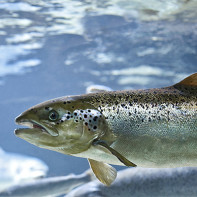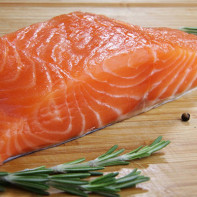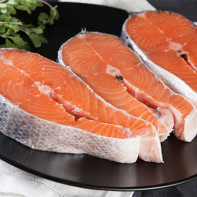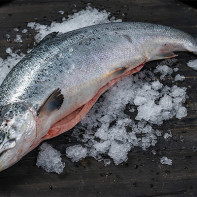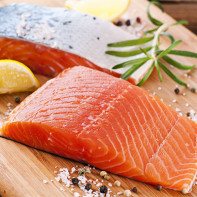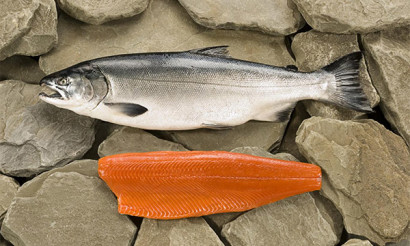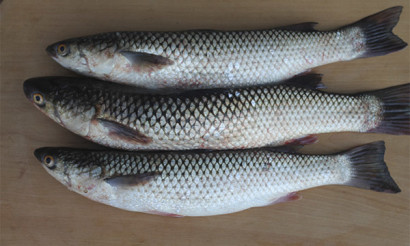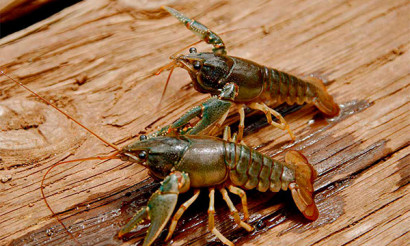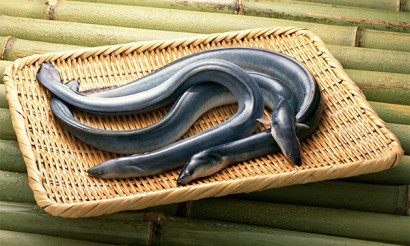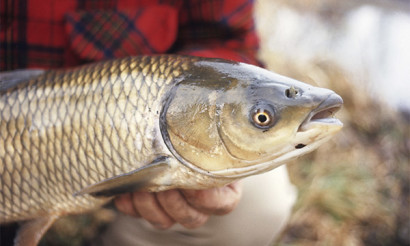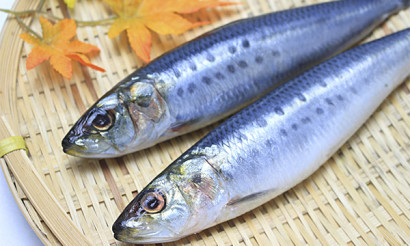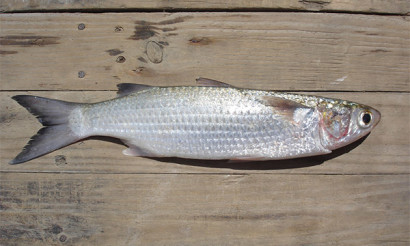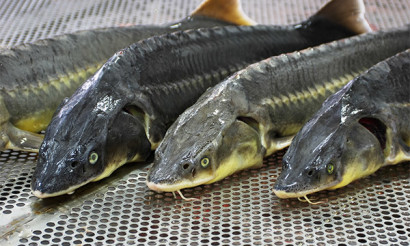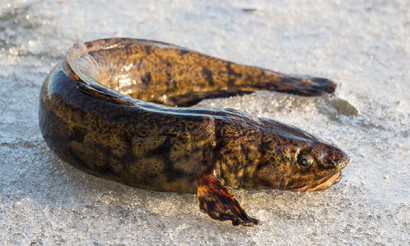Salmon: health benefits and harms
What is happiness? Each has its own criteria: for someone it is money, children, love, etc. But no matter what a person dreams of, no matter what he wants, happiness is impossible without health. That is why most people are looking for ways to preserve and support it in order to enjoy life as long as possible. And nutrition in the matter of maintaining health is an important component, because what is included in the daily diet has a direct effect on the body. In this regard, the dishes on the table should be varied and healthy. Be sure to include meat and, of course, fish delicacies in the menu, as it is the marine inhabitants who can bring incredible benefits to a person. One of such unique and useful representatives of the deep sea is salmon. What is his secret and what kind of fish, we will understand!
- What does salmon look like and where is it found?
- What is the difference between salmon
- From salmon
- From trout
- From pink salmon
- Composition and calorie content
- What is salmon good for?
- General benefit
- For women
- For men
- During pregnancy
- When breastfeeding
- For children
- When losing weight
- Which salmon is healthier: farmer or wild
- The benefits of salmon caviar
- How to pickle
- Is salmon milk useful
- The benefits and harms of smoked salmon
- The benefits of canned salmon
- Salmon fat: benefits and harms
- Salmon in medicine
- With diabetes
- With pancreatitis
- With gastritis
- With gout
- With cholecystitis
- Harm and contraindications
- How to choose and store
- Is it possible to freeze
- How to peel salmon
- How to make salmon tasty: recipes
- In the oven
- In the pan
- Grilled
- On the grill
- In a double boiler
- What can be cooked from salmon: recipes
- Salad
- Soup
- Paste
- Tartarus
- Kish
- Cutlets
- Bruschetta
- Riet
- Carpaccio
- Pate
- Roll
- Kebab
- How to taste salted salmon at home
- Is it possible to eat raw salmon
- Can animals be given salmon?
- Interesting Facts
What does salmon look like and where is it found?
In the beginning, it should be noted that salmon is not a separate fish, but a whole family of Salmon representatives. It includes sockeye salmon, coho salmon, chum salmon, whitefish, chinook salmon, omul, grayling, pink salmon, salmon and others. Science divides salmon into whitefish, grayling and salmon. The latter experts are divided into Pacific, noble salmon and char.
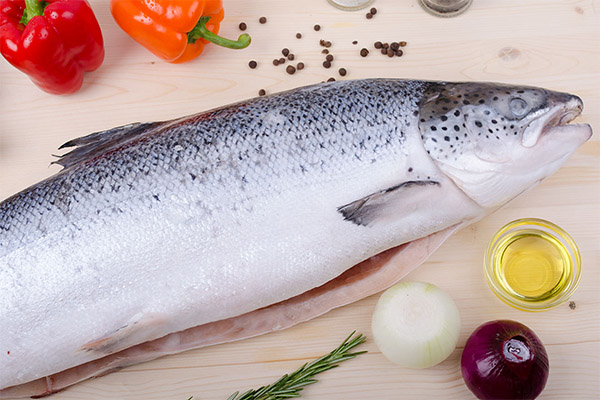
The group of Pacific salmon includes pink salmon, coho salmon, sockeye salmon, chum salmon and chinook salmon.
Noble salmon - this is trout and salmon.
As for the family itself, it was already known in the Cretaceous period, so salmon is considered an ancient fish.
The sizes of salmon can also be different and reach 200 cm, and the weight can reach the mark of 50 kg. Salmon have an elongated and narrow body, with compressed sides. The scales are colored silver with small specks, and the middle of the body is decorated with a dark strip stretching along. In general, the abdomen is always bright, but the back is darker. On the back of the fish near the tail there is a fat fin that does not have spots and rays, the rest of the fins have rays, but are devoid of teeth. The head of salmon is cartilage. The teeth are sharp. Also, fish have transparent eyelids.
Salmon are distinguished by an amazing ability to adapt to living conditions, and they can also change color to red. This mainly occurs in males before the spawning period.
Salmon lives in rivers, lakes and oceans. They were seen in the waters of the Pacific Ocean and the Atlantic, in Kamchatka, the Far East, in Yakutia and Siberia, on Lake Baikal, Onega, in the northern part of Europe. They are found in both fresh and salt water, but spawn in flowing rivers, where they swim upstream. It is this fact that served to highlight this species of fish as passing. They feed on herring, zooplankton, vendace, smelt, small crustaceans.
The most popular representatives of salmon are considered to be salmon, which in essence is called salmon, and trout, which, although different, is also part of this friendly family.
What is the difference between salmon
Salmon is a “collective image”, but it also has its own distinctive features:
- fins on the back and abdomen have rays, but do not have spikes;
- dark spots are located on the body;
- there is a longitudinal dark stripe throughout the body;
- the skeleton does not completely ossify, and therefore cartilaginous tissue remains in the head;
- there is a transparent eyelid;
- light abdomen, dark color of the dorsal part;
- powerful jaw with sharp teeth.
These are common signs of salmon, but still some fish have their own distinctive features.
From salmon
Salmon is one of the most popular members of the salmon family, which is called Atlantic or lake salmon. This fish is often called so, so the question of the difference, in principle, cannot exist. But there are some features that distinguish it:
- One of the largest salmon species. The length can reach 100 cm, and the weight can exceed the mark of 45 kg. Also, the body of the salmon is covered with even scales of silver color, but dark spots are practically absent.
- The habitats are considered to be the northwest of the Arctic Ocean, the north of the Atlantic Ocean and the Baltic Sea.
From trout
Trout is also the common name for some salmonids. There are several species - it is rainbow, lake and river. It has the following differences:
- The body is round because she is more "pot-bellied."
- The muzzle seems to be truncated.
- The scales are small.
- Paired fins are more rounded.
- Trout has a different color, which is associated with water quality. Most often, her back is painted in green-olive color, and the sides are in green-yellow. The abdomen is light.
- On each side, on the sides, are pink pearl stripes.
- Home for trout are lakes, rivers or streams.
- Fish can be considered as a migratory fish, and not be it.
- Trout caviar is larger compared to other salmon, but it is much smaller. So one individual can reproduce a total of 1000 eggs.
- The meat is colored pink, red or light in color, but it contains half as few calories as other fish of this species.
It is these signs that distinguish the appearance of trout from others.
From pink salmon
Pink salmon is one of the subspecies of Pacific salmon, but its smallest representative, although the most numerous. Pink salmon does not grow more than 70 cm and does not exceed the 2 kg mark. The fish got its name because of the hump on the back of male representatives, which appears during the mating season.
The body of pink salmon is silvery with oval dark spots. The tail has a V-shape, the mouth is white. Such fish eat very high-calorie foods, so they quickly gain weight. Wintering pink salmon remains in the water, the temperature of which does not fall below + 5 ° C. Her caviar is large, but pale. The meat is tasty and healthy, however, as with all types of salmon.
Composition and calorie content
Salmon is considered to be one of the most useful products, like all types of red fish, to the variety of which it belongs. It includes a large number of useful nutrients, among which the presence of:
- retinol
- thiamine;
- riboflavin;
- niacin;
- acids - pantothenic and folic;
- pyridoxine;
- folic acid;
- Vitamin C
- cholecalciferol;
- tocopherol;
- magnesium
- phosphorus;
- sodium;
- gland;
- Selene;
- zinc;
- calcium
- copper;
- manganese;
- potassium;
- iodine;
- omega 3;
- omega-6;
- amino acids.
The nutritional value of salmon is expressed by the following values: 20 g - protein, 7 g - fats, 0 g - carbohydrates. These figures are applicable for 100 g of fresh fish. Calorie content per 100 g is about 145 kcal.
The composition of salmon, rich in unique components, determines its benefits to the human body. Eating dishes from such meat will help prevent many diseases and maintain health.
What is salmon good for?
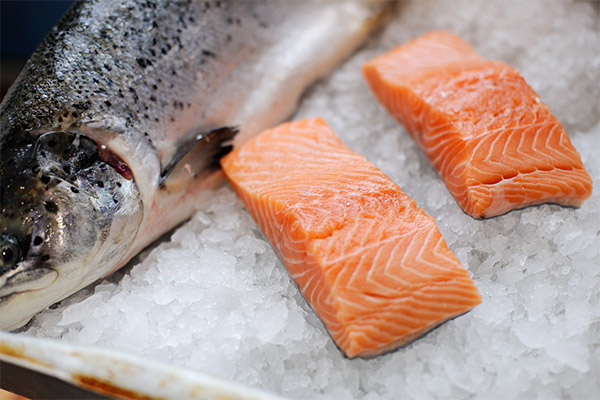
General benefit
Saturated with micro and macro elements, salmon is surprisingly beneficial for the human body.Its effect extends to the heart, and to the nervous system, to the activity of the brain, to vision and to practically the entire organism. It's all about vitamins and minerals. Thanks to them, this fish has the following effects:
- removes inflammation;
- strengthens the immune system;
- prevents the formation of blood clots leading to a heart attack;
- strengthens the work of the cardiovascular system;
- regulates the rhythm of the heart muscle;
- prevents the development and appearance of cancer;
- activates the activity of the brain;
- improves memory;
- strengthens bone tissue, hair;
- improves the condition of the teeth;
- regulates the nervous system;
- interferes with the aging process of the body;
- improves the condition of the skin and mucous membranes;
- normalizes blood pressure;
- restores vascular elasticity;
- increases the level of beneficial cholesterol;
- cleanses the body of harmful substances;
- reduces the risk of diabetes;
- improves the condition of the gastrointestinal tract;
- prevents arthritis;
- reduces the risk of macular degeneration, thereby maintaining eye health;
- normalizes the activity of the thyroid gland.
These qualities make salmon not only a delicious product that can delight a fish gourmet, but also very useful. But much depends on the individual characteristics of the body.
For women
Salmon will conquer the fair sex with its gentle taste and easy digestibility. It will also have a calming effect, help in the fight against overweight, eliminate fatigue and depression, prevent gynecological diseases, normalize the reproductive system and eliminate the risks of developing breast cancer. Well, of course, women will like the ability of the fish to take care of the condition of the skin, hair and nails. Salmon is able to rejuvenate the skin and improve its condition, while maintaining firmness and elasticity. It will help strengthen hair and nails, thereby improving their condition and general mood of women seeking to maintain their beauty and youth as long as possible.
For men
A strong half of humanity also needs to maintain their health and fitness in excellent condition. And the same salmon can help with this. This fish will restore strength after physical activity, improve metabolic processes, prevent diseases of the heart system, protect it from early baldness, speed up the process of losing weight, and reduce the risk of developing prostate cancer. The fish will prevent aging, which means it will prolong youth and preserve male power. Therefore, the stronger sex should at least once a week arrange a "fish" day with dishes of tender salmon meat.
During pregnancy
The period of bearing a baby is an important moment in the life of every woman, when the responsibility for shaping the future person lies entirely with the mother. Therefore, it is very important to monitor the proper diet, products should only be beneficial and reduce the risks of developing fetal pathologies and complications of the condition as a whole.
Salmon during pregnancy helps:
- adjust water metabolism and hemoglobin level;
- increase strength and strengthen the condition of teeth and nails;
- strengthen bone tissue;
- remove harmful substances from the body;
- normalize blood pressure;
- lower cholesterol;
- strengthen the heart muscle.
All these qualities allow the product to become an indispensable tool for maintaining the health of the future mother and baby, if not for one “but”. Salmon may contain mercury, which can even harm a child and mother in small amounts, increasing the risk of complications during this period and the development of fetal pathologies. Therefore, it is better if the use is moderate or the woman chooses the safest types of fish. In addition, if salmon is still in the grocery basket, then it should be baked, but not eaten raw, smoked or salted, because this will only increase the risks of unwanted consequences.
Of course, every mother decides for herself what is best to eat, but still sometimes it’s worth giving up your favorite dish so as not to harm the little man.
When breastfeeding
During lactation, it is the fish that will help the woman recover and saturate the milk with all the necessary elements for the proper growth and development of the baby.
Salmon in this case has a double effect, as during pregnancy. It will help strengthen the bones, teeth, hair of the mother and child, increase immunity, regulate the nervous system, and promote the proper formation of the body as a whole. But due to the presence of mercury, fish can become dangerous. In addition, some producers use antibiotics and other harmful substances during the growing of individuals, which will have only a negative effect. Also, red fish can provoke an allergic reaction.
In connection with these data, experts recommend abandoning the use of salmon or eat them with great care, given the condition of the baby and the absence of contraindications.
For children
The children's body really needs all the vitamins and minerals contained in salmon, because they regulate the state of the nervous system, and the work of the brain, and vision, and the condition of bones, teeth, skin, hair. Also, the fish gives strength and vitality, helps to cope with stress, improves memory and vision, helps to increase attention and properly form in general.
But still, this product can cause allergies. It belongs to fatty types, so it is better to refuse to use such a dish before the age of 3 years. Then it should be introduced into the diet gradually, starting from 50 g and subsequently increasing the rate to 100 g. Experts do not recommend eating salmon more than once a week in childhood. It is best to give the baby a steam or baked fish, but leave the salted and smoked for later. In any case, before starting the introduction of this product into the diet, it is necessary to consult a specialist.
When losing weight
During the diet, I really want to get rid of excess volumes as quickly as possible, but at the same time eat tasty, healthy and varied. A good dish that not only gives pleasure from the taste, but also benefits health, and also accelerates weight loss, will be salmon.
It contains omega-3 acids, which help break down fats, vitamin D, which supports bone tissue and the nervous system, B6, which helps to absorb protein, is responsible for regulating hemoglobin levels, increases muscle and heart function, and B12, which promotes protein accumulation and saturation body oxygen. These and other nutrients in the complex help to saturate the body of a dieting person with all the necessary vitamins and minerals, while helping to lose weight faster, improve skin condition and not harm. But you should eat fish about 4 times a week, and then the result will not be long in coming!
Which salmon is healthier: farmer or wild
Salmon is a healthy fish that is in high demand. Therefore, it is not only caught in places of natural habitat, but also grown on farms. Specialists have long been debating whether farm salmon is as useful as its wild counterpart.
First of all, it is worth noting that salmon are artificially fed in fisheries, i.e. they include antibiotics and other harmful substances that affect the beneficial qualities of fish in their usual diet. In addition, they may contain organochlorins, which provoke the growth of malignant tumors.
Another difference between the species is the color of the meat, which is red in wild fish and grayish in farm fish. In this regard, cunning industrialists add dyes, which also do not carry benefits for the human body. To taste, the salmon that lived in the "free" waters is much tastier than what was grown in the "pen", because the latter contains chemical compounds that affect taste.
By price indicators, farm pets are cheaper, but whether it is worth paying less for health risks - everyone decides for himself!
The benefits of salmon caviar
What triumph does without the beloved by many red caviar of salmon fish? This dish was on the tables of kings and nobles. It gained its popularity only in the 19th century, and until that time people simply threw out "fish eggs", considering them to be inedible entrails. But then red caviar won the hearts (or stomachs) of gourmets around the world.

This delicacy captivates with its taste, but its useful properties, which include:
- prevention of atherosclerosis and rickets;
- increase immunity;
- strengthening bone skeleton, hair and nails;
- maintaining and rejuvenating the skin;
- regulation of the circulatory process;
- lowering blood pressure;
- normalization of the cardiovascular system;
- increased potency;
- regulation of the nervous system;
- increased hemoglobin;
- vision improvement;
- cancer cell neutralization;
- activation of brain activity.
These properties of red caviar are explained by the presence of the following useful substances in its composition:
- vitamins of groups B, A, E, C, D;
- sodium;
- omega 3;
- sulfur;
- phosphorus;
- gland;
- calcium
- zinc.
But nevertheless, in spite of all the benefits and uniqueness of red caviar, one should not forget about the contraindications of a gourmet product, which include:
- individual intolerance;
- kidney disease
- urolithiasis disease;
- children's age up to 3 years;
- hypertension (with caution);
- coronary heart disease (with caution).
To avoid possible risks, experts recommend eating no more than 5 tsp per day. caviar, while choosing a high quality product. Cheap caviar can be dangerous due to the content of formaldehyde in it, which is formed during the breakdown of urotropin, a preservative used to extend the shelf life of unscrupulous manufacturers. The real product, used in moderation, can only bring benefits!
How to pickle
To enjoy red caviar, it is not necessary to run to the store. If there is fresh caviar, then you can pickle it yourself, since no special appliances and cook diplomas are needed. You should only follow the recipe and take the advice of professionals:
- If a person decides to salt caviar himself, then first he will have to buy fish, which actually contains a precious product. You need to choose a female salmon. In appearance, the fish-girls are more rounded, with a smaller head and do not have sharp and sharp endings, unlike the fish-boys. If a female is really chosen, then in it 100% there will be caviar, because salmon are caught just before spawning. Then the fish must be thawed at room temperature and only then begin the process of preparation and salting.
- Having delivered the caviar, you can see that all of it is in a certain film or pail, which should be cleaned by hand, while acting carefully so as not to damage the eggs. Place the peeled product in a dish with cold water and start stirring with a wooden stick, rotating it in one direction. The remaining parts of the tongue will be wound on a stick. Next, put the caviar in a colander, covered with a layer of gauze, and after all the liquid has drained, mix again with a skewer, but on a dry cloth. So, all damaged testicles and films will be on gauze.
- The next step is the preparation of the marinade or brine. To make it, you need water, the volume of which should completely cover the caviar. Also need sugar, based on 2 tsp. 250 ml of water, and 2 tbsp. salt to the same amount of liquid. Having mixed all the products, the brine must be boiled and cooled to room temperature, because with too hot water, the caviar may simply curl.
- At the final stage, caviar should be filled with ready-made warm marinade and left to stand for about 15 minutes. Then lay it on cheesecloth and let the liquid drain (this can take a long time).After the product is transferred to glass jars, which are previously lubricated with vegetable oil, and refrigerated.
After 4 hours, the red caviar will be ready. You can please guests and loved ones.
Is salmon milk useful
Salmon females give a person healthy and tasty red caviar, but males do not stand aside: they contain milk of unique composition, which is also very useful for the human body.
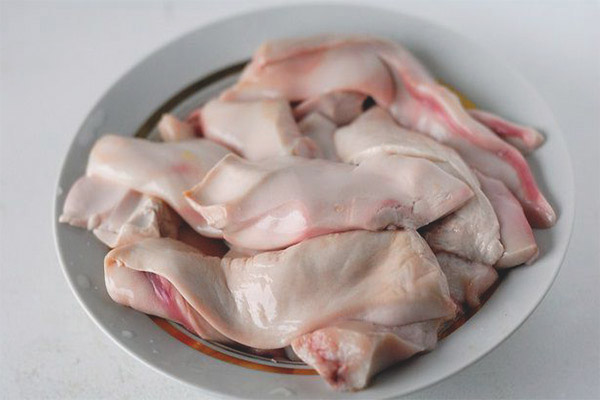
Milk is the seminal gland that can be found in males. They are painted white, which is why they got their name.
Milk contains:
- retinol;
- acids - nicotinic, ascorbic, folic;
- B vitamins;
- tocopherol;
- phosphorus;
- sodium;
- potassium;
- magnesium;
- iron;
- polyunsaturated fatty acids.
These components determined the beneficial effect of milk, which consists in such abilities as:
- regulation of the heart and blood vessels;
- maintaining the elasticity of the walls of blood vessels;
- reduction in the amount of bad cholesterol;
- regulation of the central nervous system and brain;
- extending the duration of exposure to certain medications (e.g., insulin);
- increase immunity;
- glucose normalization;
- regulation of the process of hematopoiesis;
- bone strengthening;
- liver cleansing;
- UV protection;
- improving the condition of the skin;
- strengthening hair and nails;
- increased potency;
- increased sexual desire;
- prevention of diseases of the genitourinary system.
As for the harm, then, in addition to the individual intolerance to the product, there is nothing to replenish this list!
Thus, milk is really useful for the human body and deserves to take pride of place among fish delicacies.
The benefits and harms of smoked salmon
Many people like to treat themselves to delicious smoked salmon meat, but not everyone thinks about the dangers and benefits of this dish. In order to assess its true effect on the body, you must first understand the ways of smoking fish. There are only three of them: cold, hot and the method of smoking using "liquid" smoke.
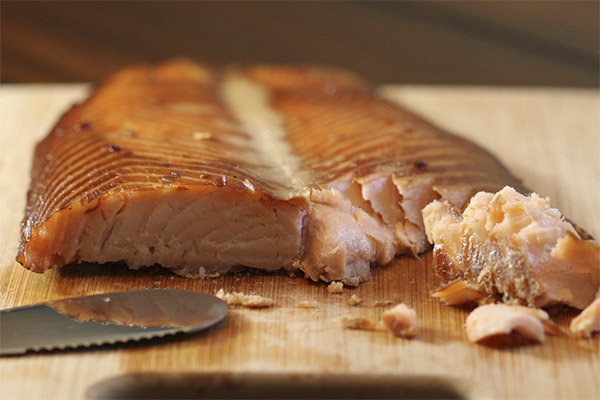
- The first option uses fish processing at a temperature of 20 to 30 ° C.
- The cooking temperature in the second case can vary from 45 to 120 ° C.
- The third method involves the use of artificial fluid, which gives the fish or meat the taste and smell of a smoked product.
All three methods are popular, but only fish cooked first, i.e. in a cold way can benefit a person. It is the cold version of smoking that saves most of all useful nutrients, and there are a lot of them in smoked salmon:
- vitamins E, D, B12;
- manganese;
- iron;
- zinc;
- selenium;
- fluorine;
- calcium;
- magnesium;
- potassium;
- omega-3 and -6;
- phosphorus.
This composition allows the product to have the following effects on the body:
- Reduce the risk of diseases of the cardiovascular system, asthma, psoriasis, arthritis.
- Eliminate inflammation.
- Prevent the development of certain oncological diseases (for example, prostate cancer).
- Normalize brain function.
But with all the advantages, experts still do not recommend abusing such food, because with the hot method of smoking in food, a sufficient amount of carcinogens accumulate, leading to the occurrence of cancer. The cold method is dangerous by infection with parasites, because product processing temperature is too low. Well, the use of "liquid smoke" is generally a chemical process that will only aggravate the state of the body without doing any good to it, but harm is likely.
Also, do not forget that this type of salmon is harmful to people with gastrointestinal diseases, kidney and liver diseases. Pregnant and lactating product is also not recommended, as well as children under 5 years.
But this does not mean that smoked salmon should be discarded. Experts believe that when you use smoked delicacy about 2 times a week, 100-150 g per day will not harm the body.
The benefits of canned salmon
Canned salmon is another delicacy made from the meat of a unique fish. In fact, this is a very tasty and really healthy dish, because canning preserves almost all the useful substances of a fresh product.
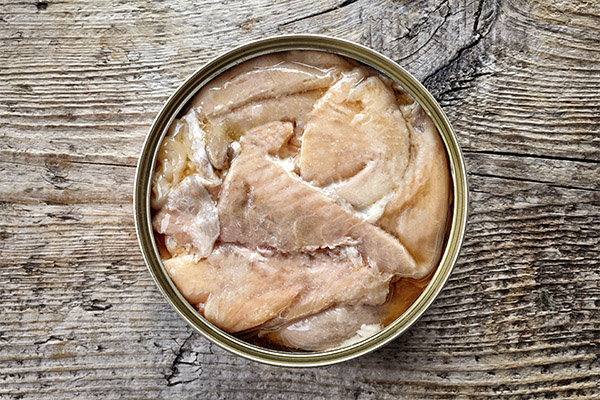
In canned food of this fish can be found:
- cyanocobalamin;
- pyridoxine;
- nicotinic acid;
- calcium;
- potassium;
- selenium;
- magnesium;
- phosphorus;
- omega 3.
These vitamins and minerals help a person cope with metabolic disorders in diabetes mellitus, prevent the occurrence of Parkinson's and Alzheimer's. They can also preserve and improve the appearance of the skin, strengthen hair and nails, support the human skeleton, inhibit the aging process, regulate the nervous system, hormonal levels in adolescents, restore vision, protect against thrombosis, lower blood pressure, increase immunity and maintain microflora intestines.
It is also worth noting that, having bought canned food, you should not worry about where you got the fish itself: on a farm or at sea. Wild salmon is used for the production of canned food, and therefore a canned product is recognized as the most useful dish, the use of which will surely restore and maintain health, of course, if there is no individual intolerance.
Salmon fat: benefits and harms
Probably every person from early childhood heard about the benefits of fish oil. And it’s not just that. This product is really very beneficial for human health. Due to the content of omega-3 and omega-6 acids, vitamin D, it is able to exert a general strengthening effect, inhibit inflammatory processes, and regulate lipid levels. It can also destroy cholesterol plaques, reduce the risk of the occurrence and development of cardiovascular disease, be a prophylaxis against rickets, help strengthen bones and promote healthy bone skeleton formation. It prevents arrhythmias, restores vascular elasticity, forms brain cells, and normalizes the thyroid gland.
It would seem that the product has no contraindications, but there are risks of negative reactions after its use. First of all, it contains cholesterol, so fat should be taken in a strictly specified dose. In addition, salmon contains mercury, which is very dangerous for people of any age and gender, and it is likely that a dangerous element can also be found in this product. Therefore, you should only purchase high-quality fish oil, because well-known enterprises and medical corporations cleanse the product of harmful and dangerous substances.
Salmon in medicine
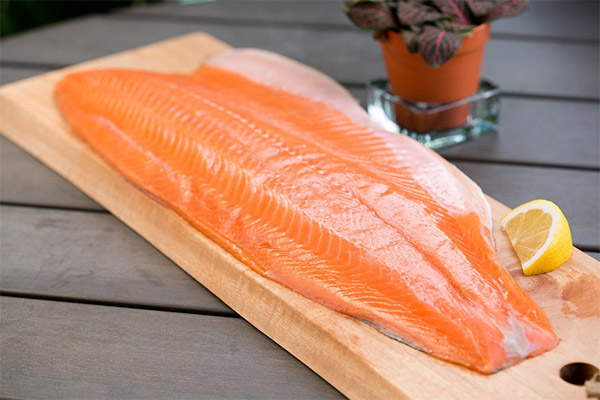
Tasty fish gained its popularity not only as an amazing dish in the hands of a skilled cook, but also as a means of getting rid of many ailments. Her meat will be useful in the following diseases:
- increase in cholesterol;
- atherosclerosis;
- diabetes;
- arthritis;
- inflammation of the skin;
- kidney disease
- tissue injuries of a different nature;
- leukemia;
- cancer of the breast, prostate, ovary, brain;
- decreased immunity;
- disturbances in the work of the nervous system;
- hair loss;
- memory impairment;
- vision problems;
- aging process;
- the threat of heart attack and stroke;
- arrhythmia;
- hypertension;
- depression;
- macular degeneration;
- joint inflammation.
Thus, salmon exerts its magical healing qualities, affecting almost all spheres of the human body. But about some serious diseases it is worth talking separately.
With diabetes
Diabetes mellitus is the reason for the prohibition of many foods that can harm the patient. But this does not apply to salmon.Moreover, doctors recommend including such a product on the patient’s menu without fail, but not more than 150 g per day and limit the use to a double dose per week. This is due to beneficial amino acids and minerals that help lower glucose levels, help to remove harmful substances from the body, reduce the risks of cardiovascular diseases, strengthen immunity, and avoid problems with the musculoskeletal system.
At the same time, it is better if the fish is served in a baked version or canned. In this case, the use of salmon promises only benefit and reduce possible unpleasant consequences and deterioration provoked by diabetes.
Important: the glycemic index of fresh salmon is 0 units.
With pancreatitis
When inflammation of the pancreas, doctors recommend abandoning fatty varieties of fish, but the use of salmon is permissible due to the content of unique nutrients in them, which can improve metabolism and lower cholesterol. In this case, fish should be selected with a lower percentage of fat content, and served in baked, boiled or stewed forms. The daily rate, according to doctors, should not exceed 200 g. Once a week, the use of salmon will have a beneficial effect on the patient's body and will not cause harm. But in any case, it is worth consulting with a specialist about the possibility of eating fish.
With gastritis
Salmon with a disease such as gastritis is a more useful product. It is perfectly absorbed, contains protein, which is necessary for the patient, has a beneficial effect on the mucous membranes, saturates the body with useful micro and macro elements, improves digestion. But still, many salmon fish are a fatty product that is contraindicated in such an illness. Therefore, you should choose less fatty varieties, and if you use salmon, then only steamed or in soups, and you should completely refuse smoked, salted and canned food options.
With gout
Gout is a disease when a large amount of uric acid is released in the body. At the same time, its crystals are deposited on the joints. To remove pain and avoid attacks, you must strictly follow a diet that includes foods that can reduce purine levels. That is why salmon is not recommended as a permanent dish in the patient's diet. Sometimes you can treat yourself to a small piece of fish meat, but you can’t do this weekly in any case, because salmon contains a large number of purines and can lead to complications in the patient's condition.
With cholecystitis
When the walls of the gallbladder become inflamed and there is a violation of the outflow of bile, cholecystitis occurs. With this disease, it is very important to follow a strict diet aimed at removing bile from the body. Fish, although it is a healthy product for humans, but some of its varieties are prohibited for patients with pancreatitis, and salmon is one of them. Therefore, the use of salmon in this disease is prohibited in any form.
Harm and contraindications
All food, medicinal herbs, medicines have two sides - positive and negative. And there are no exceptions. Therefore, salmon, whose rich composition is able to have an amazing effect on human health, also has the following contraindications:
- individual intolerance;
- allergy;
- children's age up to 3 years;
- pregnancy and lactation (with caution);
- gout;
- pancreatitis
In other cases, preference should be given to wild fish, which really will benefit and does not conceal the danger of a possible chemical "poison" contained in individuals raised on fish farms.
How to choose and store
A correctly selected salmon will help to improve health and feel the real taste of the most tender meat. So that dinner or lunch is not spoiled, you must follow the advice of professionals to help make the right choice:
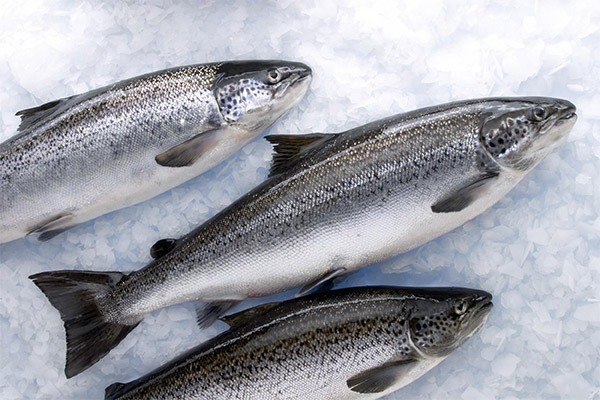
- It is preferable to purchase fresh fish, as she is able to "tell" about her quality much better than frozen.
- The smell should resemble a salty sea.
- The color of the flesh of salmon is a delicate pink color, while a paler color indicates a re-freezing of the product. Bright and saturated color means the use of dyes.
- It is better to buy a fish with a head, because it is the purity and clearness of the eyes that indicate the freshness of the product.
- When choosing steaks, you can slightly “crush” the meat with your finger, the pit of which with fresh salmon will quickly restore shape.
- If whitish streaks are visible on the pulp, then such a purchase should be discarded, because salmon is certainly grown artificially.
- Wild varieties of fish are acquired, starting from the last month of winter and ending with the last month of summer. In other cases, they sell a "farmer" representative.
- When choosing salmon in vacuum packaging, you need to familiarize yourself with the composition, where only fish and salt should be present, and the water content in the product itself is unacceptable.
These expert recommendations will help in buying real, tasty and healthy salmon. But that's not all! Having bought a good product, in this case red fish, you need to store it in the right way. Fundamental rules:
- Salmon should be stored on the upper shelves of the refrigerator for no more than 5 days.
- During the shelf life, fish should not be removed from its packaging. It can be stored in an open state for no longer than 10 days.
- Salted salmon can be stored for about 3 weeks.
- Fish should lie separately from other products and be wrapped in foil.
- The chilled product is better stored on the ice cushion in the upper zone of the refrigerator.
- To increase the shelf life of salmon, you can get it wet with a cloth dipped in vinegar.
Using these rules, you can keep the product fresh, and therefore useful.
Is it possible to freeze
Salmon lends itself to freezing. Its storage temperature should be -18 ° C or -20 ° C. Shelf life will then reach 4 months.
To freeze fish, you need to make sure it is fresh, and if the product was purchased already frozen, you should not allow it to thaw and immediately put it in the freezer. After defrosting, salmon should be consumed immediately, as its repeated freezing is not allowed.
How to peel salmon
Cleaning and cutting fish is an "amateur" activity, however, they can not be avoided. When cutting salmon, you should go through the following steps:
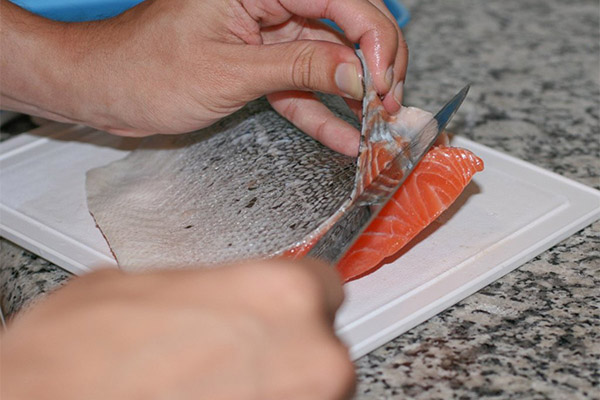
- Having made an incision in the abdominal cavity, get rid of the insides.
- Using a knife with a short blade or a special one for cleaning fish, get rid of scales, cleaning in the direction of the head. If the process is difficult, then salmon can be doused with boiling water.
- Rinse the fish and dry with a towel.
- Separate the head under the gill bone in a circular motion, while holding the fin located in the neck of the carcass with the other hand.
- Remove the caudal fin by trimming it on both sides in the form of a triangle.
- Separate the rib bones from the inside, making a cut on the skin and dividing the fish into two halves.
- Remove the spine by holding it with a tissue or tissue so as not to get hurt.
- Remove the upper ridge with a sharp knife.
- Cut the film by removing the ribs and separate the carcass.
- Take out the remaining bones, making a slight bias to the abdominal part.
- Separate the skin starting from the head. To do this, lay the carcass with the skin down and use a sharp knife to cut it “in one motion”.
Next, the fish must be cooked according to the preferences of the cook.
How to make salmon tasty: recipes
Fish lovers are unlikely to think about the benefits of the product, enjoying the tender and juicy salmon meat prepared by a skilled craftsman. But the recipes for such dishes are quite accessible to ordinary housewives, who are able to cook fish in their own kitchen.
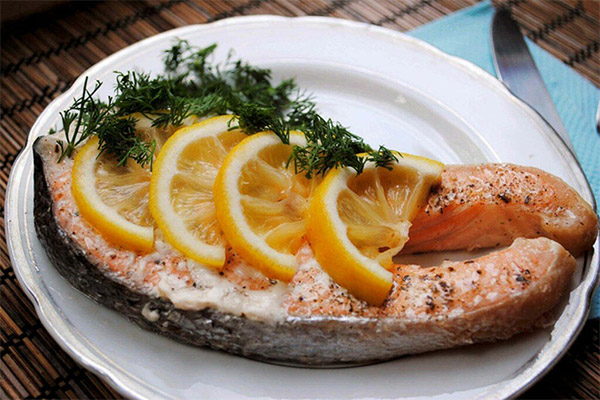
In the oven
Ingredients:
- 0.9 kg salmon fillet;
- 80 g of mustard (Dijon);
- 80 g of liquid honey;
- 10 g of dill;
- 60 ml of olive oil;
- 15 g of garlic;
- 20 ml of lemon juice;
- salt.
Cooking method:
- Wash and dry all ingredients.
- Remove the garlic from the husk and wipe with a fine grater, but not through a press.
- In a container, combine honey, mustard, garlic and 2/3 of the oil, lemon juice, herbs and salt. Stir all components thoroughly.
- Divide the prepared fillet into five portions and grease each with the remaining oil.
- Cover the baking sheet with parchment and put the fish fillet on it, smearing it on top with the prepared mustard-honey mixture.
- Place in the oven preheated to 200 ° C and cook for 10 minutes.
In the pan
Ingredients:
- 300 g salmon fillet;
- 2 tbsp flour;
- 1 egg
- 0.5 cup walnuts.
Cooking method:
- Grind the nuts and divide into two parts.
- In a separate bowl, mix the flour with the egg using a blender, and then attach half the volume of nuts to the mixture.
- Rinse and dry the salmon in advance, then soak thoroughly in nut-and-egg batter and roll in nuts.
- Put the fish fillet in batter and nuts in an already heated pan and cook for 4 minutes on each side. At the same time, the fire should be weak, and the lid of the pan should be closed during roasting.
Grilled
Ingredients:
- 4 slices of salmon steak;
- 3/4 cup dill greens;
- 1 tbsp tarhuna;
- 1 tsp granulated sugar;
- 1 tsp lemon peel;
- 1 tbsp flavourless vegetable oil.
Cooking method:
- Grease steaks with vegetable oil on all sides.
- The remaining components are mixed together in a separate bowl.
- Put the fish in the resulting marinade for a quarter of an hour, then put the salmon on a preheated grill and cook for 10 minutes.
On the grill
Ingredients:
- 0.75 kg of salmon fillet;
- 250 g of brown sugar;
- 38 ml of lemon juice;
- 63 ml of olive oil;
- 63 ml of soy sauce;
- 38 ml of water;
- 2.5 cloves of garlic;
- salt.
Cooking method:
- In a dense plastic bag, combine all the components except the fish and mix thoroughly with each other.
- Cut salmon into 5 portioned slices and transfer them into a bag.
- Mix the fish thoroughly with the marinade and put the packet in the refrigerator for 3 hours.
- Over time, lay the fish on the grill and barbecue melted in advance.
- Cook for about 10 minutes, occasionally turning pieces of salmon.
In a double boiler
Ingredients:
- 0.4 kg salmon filet;
- 5 g of lemon peel;
- 5 ml of lemon juice;
- 40 g of rosemary;
- 0.6 l of water;
- salt.
Cooking method:
- Cut the washed fillet into 4 portions, salt, drizzle with lemon juice and sprinkle with zest, then leave to stand for 7 minutes.
- Pour water into the slow cooker by adding rosemary to it.
- Install a special steam sieve on which to place the salmon.
- Set the tumbler in the "steam" mode, and cook the dish for about 15 minutes.
What can be cooked from salmon: recipes
There are many recipes for a variety of dishes that are prepared from amazing salmon meat. Here are just some of them.
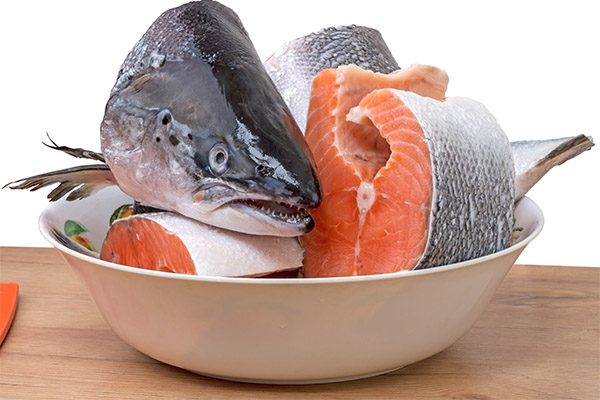
Salad
Ingredients:
- 200 g of slightly salted salmon fillet;
- 100 g canned corn;
- 2 tbsp lemon juice;
- 150 g Philadelphia cheese;
- 3 slices of white bread;
- 2 tbsp vegetable oil;
- 1 avocado;
- oregano;
- basil;
- ground pepper;
- salt.
Cooking method:
- Mix salt, pepper, oil in a container.
- Cut white bread into small pieces and moisten them in the resulting spicy-butter mixture, then fry the crackers in a pan without adding oil.
- Cut the peeled avocado into cubes and sprinkle with lemon juice.
- Cut salmon into cubes, combine with cheese and mix.
- Next lay the dish in layers in the following order: salmon with cheese, avocado, corn and crackers.
Soup
Ingredients:
- 300 g of salmon;
- 280 g of tomatoes;
- 450 g of potatoes;
- 1 carrot;
- 1 onion;
- 0.5 l of cream 20%;
- dill greens;
- 1 liter water;
- pepper;
- 1-2 tbsp odorless vegetable oil;
- salt.
Cooking method:
- Finely chop the onion, rub the carrots with a coarse grater, free the tomatoes from the peel and cut into cubes. Also cut peeled potatoes into cubes.
- Add oil to a 3-liter pan and heat it, then transfer the onions there. When it changes color, attach the carrots.
- Then transfer the tomatoes to the pan and fry for about 3 minutes. Then add water and wait for the liquid to boil.
- After that, put the potatoes in vegetables and cook the soup for 6 minutes, adding salt.
- Over time, attach the fish and pour the cream in a thin stream. Cook for about 5 minutes. Turn off the flame, add salt and greens.
Paste
Ingredients:
- 300 g salmon fillet;
- 250 g tagliatelle pasta;
- 150 ml cream 20%;
- 2 tbsp olive oil;
- 10 g of parsley;
- Parmesan cheese
- pepper;
- salt.
Cooking method:
- Boil the pasta until cooked.
- Cut the fish fillet into small pieces and fry briefly with olive oil, then mix with herbs.
- Add cream, salt and pepper. Wait for the cream to boil and boil for about 2 minutes.
- Transfer pasta to salmon, mix and arrange the dish in portions, sprinkled with cheese.
Tartarus
Ingredients:
- 300 g salmon fillet;
- 3 shallots;
- 5 feathers of green onions;
- ½ avocado;
- 1 tbsp capers;
- 1 tbsp lemon juice;
- 1 tsp soy sauce;
- 1 tbsp olive oil.
Cooking method:
- Cut the fish into small cubes.
- Onions (both species), capers finely chop.
- In a separate bowl, combine oil, juice, sauce and pepper (if necessary) and add fish, onions and capers to this mixture. Stir.
- Small cubes of avocado also attach to the remaining ingredients and put the resulting product in the refrigerator for 30 minutes.
Kish
Ingredients:
- 150 g of salted salmon;
- 200 g of flour;
- 100 g butter;
- 200 ml cream 20%;
- 4 chicken eggs;
- 5 tbsp water;
- 150 g of grated cheese;
- 1 onion;
- dill;
- salt.
Cooking method:
- Combine flour, salt and small and chop with a knife. Then add water (ice) and knead the dough.
- Roll out the layer and shift it into shape (it is better to take a detachable version). Refrigerate for 15 minutes.
- Chopped cake with a fork, cover with parchment and sprinkle with peas or beans to maintain the concavity of the form.
- Preheat the oven to 200 ° C and bake the base for a quarter of an hour, then get rid of peas and paper and let the product stand for about 5 minutes.
- Beat cream and eggs with a blender, add salt and pepper.
- Stew the onion chopped in half rings in olive oil, and then shift it to the base for the quiche. Add salmon slices there and sprinkle all this with cheese and herbs.
- Pour the egg mixture into the cake mix and put everything in the oven, where to cook until the golden crust appears.
Cutlets

Ingredients:
- 0.5 kg of salmon fillet;
- 2 onions;
- 2 eggs;
- 2 tbsp vegetable oil (and a little more for frying);
- dill and parsley;
- 0.5 tsp soda;
- 1 tsp salt.
Cooking method:
- Grind the fish fillet with a blender.
- Grate the onion with a grater. Finely chopped greens.
- Shuffle all components.
- Put the mass on a hot frying pan with a spoon and form the shape of cutlets.
- Cook the dish in a medium flame until a delicious crust forms.
Bruschetta
Ingredients:
- 150 g salmon fillet;
- 100 g of fresh cucumber;
- 3 slices of white bread;
- 50 g cream cheese;
- 10 g cream 20%;
- 10 g of olive oil;
- 1 lemon
- oregano;
- pepper;
- arugula;
- parsley greens;
- salt.
Cooking method:
- Remove the peel from the cucumber and cut it into cubes.
- Cut the fish into small cubes as well.
- In the container, add the cucumber and ½ lemon juice to the salmon, then add oregano and olive oil. Stir and let stand for about 20 minutes.
- Combine finely chopped greens with cheese and cream, salt, pepper and pour the remaining juice from the other half of the lemon. Stir well.
- Dry the bread slightly in the oven for 5 minutes at a temperature of 180 ° C.
- Put cheese mass on slices of bread, and lay salmon on top.
Riet
Ingredients:
- 0.2 kg smoked salmon filet;
- 0.5 kg of fresh salmon fillet;
- 50 ml of yogurt without additives;
- lemon;
- 80 g of sour cream 20%;
- a mixture of black and white peppers;
- dill greens;
- salt.
For fish stock:
- 700 ml of dry white wine;
- 3 leaf parsley;
- bulb;
- 6 sprigs of parsley.
Cooking method:
- In a saucepan, combine alcohol, parsley, parsley and boil for 5 minutes.
- Boil fresh fish fillet in broth for about 10 minutes. Cool.
- Squeeze juice out of half a lemon. Finely chop dill.
- Finely chop the smoked and boiled salmon, removing the skin.
- To boil the boiled fish with a fork and connect with the rest of the components.
- Cover the prepared riet with a plastic bag or plastic wrap and refrigerate where it should stand for at least 4 hours.
- Riet spread on toasts.
Carpaccio
Ingredients:
- 0.5 kg of fresh salmon fillet;
- 20 g chives;
- 1 fresh cucumber;
- 2 tsp capers;
- 100 ml of olive oil;
- 2 lemons;
- black pepper;
- salt.
Cooking method:
- Freeze the fillet in the freezer for 60 minutes, then cut into thin, translucent plates and put on a serving plate in one layer.
- Peel the peel from the cucumber and cut it into long, thin strips. Next put them on the fish.
- Chop the onion with scissors and sprinkle on top of the dish.
- Wash capers in water and put in a chaotic manner on the fish.
- Squeeze the juice from the lemons and brush all the salmon pieces with a brush.
- Pour olive oil onto a plate in a thin stream.
- Add salt and pepper, then cover with cling film and put the carpaccio in the refrigerator, where it is held for about 20 minutes.
Pate
Ingredients:
- 250 g smoked salmon;
- 250 g Philadelphia cheese;
- 2 tbsp lemon juice;
- black pepper.
Cooking method:
- Cut the fillet into pieces and combine it in a blender bowl with cheese, lemon juice and pepper, and then carefully tour.
- Transfer the prepared paste into serving dishes and garnish with red pepper peas.
Roll
Ingredients:
- 0.4 kg salmon filet;
- 4 tbsp sour cream 30%;
- 6 eggs;
- 500 g of frozen green peas;
- 200 g of frozen spinach;
- half a lemon;
- ground black pepper;
- salt.
Cooking method:
- In a blender bowl, combine salmon, 3 eggs, half the volume of sour cream, a quarter of the volume of lemon juice and spices, and then tour.
- Boil peas for 3 minutes in brackish water, combine it with spinach, remaining eggs, half sour cream and a quarter of lemon juice. Next, mix the combined ingredients with a blender.
- Grease the baking dish with oil and spread the mass in layers - first fish, then vegetable and then repeat the process.
- Then cover the resulting puff product with foil and put the form itself in a larger container, while under the dishes with the future roll, there should be a thick piece of fabric.
- Pour water into a larger mold to the middle of the roll form and place the “structure” in the oven preheated to 180 ° C for 60 minutes.
- Cool and refrigerate.
Kebab
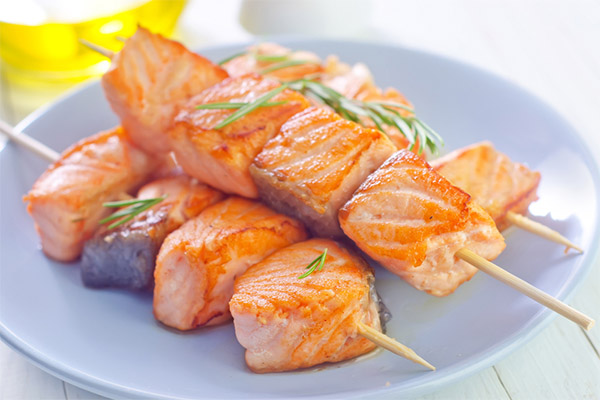
Ingredients:
- 1.5 kg fillet of fresh salmon;
- 1 onion;
- ½ lemon;
- a bunch of cilantro;
- 70 g odorless vegetable oil;
- salt.
Cooking method:
- Combine chopped onion with finely chopped cilantro and other ingredients except fish.
- Cut salmon into portions and marinate in the resulting marinade for half an hour.
- Put the fillet on a skewer or skewers, alternating with tomatoes or other vegetables (optional).
- Cook on charcoal for 9 minutes.
How to taste salted salmon at home
Many people like to enjoy salted salmon, but you can cook it at home yourself, while the product will be more tasty and healthy than the "store" option. In addition, this will save the family budget.
There are various methods of salting, but the simplest and most popular is the cold salting, when the fish is simply covered with salt and sugar and salt itself.
For salting, it is necessary to stock up 0.5 kg of salmon fillet with skin, 2 tbsp. ordinary table salt and 1 tsp. granulated sugar. Next, you need to rid the fish of excess moisture with paper napkins.After combining the salt and sugar, and in this mass, properly roll the pieces of salmon to get a dense crust. Then put the fillet on the skin in a ceramic container and cover with a film. Then put the fish in the refrigerator for 24 hours. During this time, it is necessary to drain the resulting liquid from dishes with fillets 2-3 times. The next day, rinse the fish and pat with vegetable oil.
This method does not take much time, and the result will please the taste. It should be remembered that salmon should not be salted in metal dishes.
Is it possible to eat raw salmon
Carpaccio lovers often wonder about the safety of eating raw salmon meat, because such products can infect humans with parasites or intestinal viruses. In addition, the fish is able to absorb the harmful substances of those waters that served as its home. Nevertheless, experts say that raw salmon is quite suitable for consumption and practically safe, but only if it lived in salt water, where the parasites simply do not survive. But this does not mean that there is no risk of infection. It is necessary to observe the measure and not abuse the product.
Can animals be given salmon?
Not only people like to taste a slice of another tender salmon meat. Animals are also big lovers of fish, especially cats and dogs. Salmon for tetrapods will also be beneficial. It is able to improve the skin and coat of a pet, strengthen the immune system, saturate with minerals and vitamins, and become an excellent source of healthy protein.
Nevertheless, experts do not recommend giving salmon to animals raw and with skin in order to avoid digestive problems. In addition, using a raw product, the animal may well become infected with parasites and become a carrier. In this regard, salmon is better to boil or bake, but without salt and spices. In this form, it will bring the pet one only benefit.
Interesting Facts
Salmon is an ancient fish, which means it has a rich history. A lot of amazing facts are known about her:
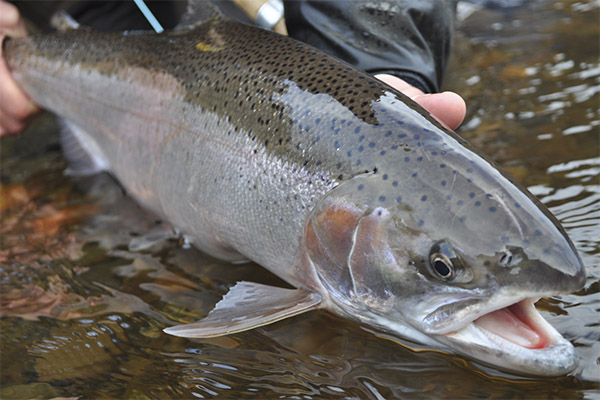
- The pink color of salmon meat is directly related to the fish's diet, which includes crustaceans containing a special pigment, coloring and salmon meat.
- Chinook salmon is considered the largest representative of the salmon family, whose body length can reach 1.5 m.
- The most salted salmon fish taste is pink salmon.
- Before spawning, male salmon cease to eat.
- Depending on the habitat, salmon may change color and shape.
- A salmon jump over water can be 30 cm.
- Salmon can find its place of birth by smell and moon.
- After spawning, ¾ fish die.
Here is such an amazing fish that lives in the water depths. It is able to cure ailments and maintain beauty. That is why salmon has gained recognition of gourmets around the world and continues its victorious march on the planet.
«Important: all information on the site is provided exclusively in fact-finding purposes. Before applying any recommendations, consult with a profile specialist. Neither the editors nor the authors are liable for any possible harm caused materials. "

